The Shipyards
I will use abbreviations for most of the Scandinavian shipyards in the presentation of the ships. An explanation to these abbreviations will be presented below.
EMV
ERIKSBERGS MEKANISKA VERKSTAD
GV, GVA
GÖTAVERKEN-ARENDAL
KMV
KOCKUMS MEKANISKA VERKSTAD
LMV
LINDHOLMENS MEKANISKA VERKSTAD
MOTALA VERKSTAD
UV
UDDEVALLAVARVET
GVÖ
ÖRESUNDSVARVET
WÄ
WÄRTSILÄ
B&W
BURMEISTER & WAIN
MOTALA MEKANISKA VERKSTAD.
The birthplace of the Swedish shipping industry was Motala Verkstad, which was founded in 1822. The works was constructed at the same time as the Göta Kanal was built and manufactured machines and equipment that were required during this building project.
Gradually the workshop also started to build ships. In 1858 Lindholmens Warf in Göteborg was purchased in order to be able to build larger ships. In 1892 Motala Verkstad went bankrupt and Lindholmen was sold on a compulsory auction. The operations continued and in 1920 Lindholmens Verkstad purchased the business. The name was now changed to AB Lindholmen - Motala. Motala Verkstad is still active today as a manufacturing industry but they haven’t produced ships for a very long time.
LINDHOLMENS MEKANISKA VERKSTAD - GÖTEBORG.
Lindholmen delivered its first ship in 1848 but the essential business didn’t start until 1858 when Motala verkstad became the main owner of the shipyard. The shipyard was situated on the Hising-side of Göta Älv from the beginning. During the depression at the end of the 1920s the construction of new ships almost ceased completely. In 1933, the Johnson-concern took over the shipyard and this initiated a new era of greatness for Lindholmen. In 1970 the shipyard was taken over by the Broström concern that already owned Eriksberg, which is Lindholmens closest neighbour. Broström carried out a fusion of the shipyards in 1971.

KOCKUMS MEKANISKA VERKSTAD - MALMÖ.
The shipyard has its lineage from the industrial business that F H Kockum founded in Malmö in 1840. The manufacture was to include several industrial products, such as railway carriages. In 1873 he delivered the first ship from KMV. The shipyard grew in extent and after a sharp expansion during the 1950s and 1960s the shipyard became one of the world’s largest. During the 1970s the production was dominated by long series of large tankers. In connection with the shipyard crises at the end of the 1970s the government took control over KMV in 1979 and the shipyard became a part of Svenska Varv. The object of Svenska Varv was to reorganize the Swedish shipbuilding industry. In 1986 there was a decision to cease with all civil production of ships. After this decision the shipyard has changed directed it’s production into submarines for instance.
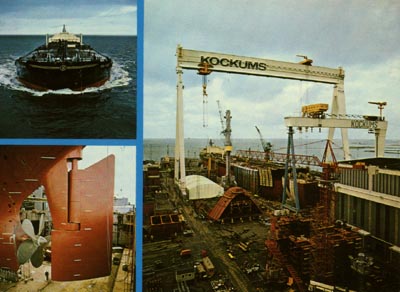
UDDEVALLAVARVET.
During the second word war the USA rapidly built up its shipyard capacity. They wanted to get rid of some of this capacity after the war. Ship owner Gustav Thordén bought the Kayser shipyard, had it dismounted and transported the equipment to Uddevalla. The first ship was delivered already in 1947. In spite a lot of orders coming in and an expansion of the works the shipyard became insolvent. In 1963 the Swedish state and the Eriksbergsvarvet took over. In 1970 the state bought Erikberg’s 50 percent share and the shipyard became a part of Statsföretag. In 1977 the shipyard was transmitted to the newly formed Svenska varv. Uddevallavarvet delivered T/T Nanny, with 499000 DW the largest ship ever built in Sweden, in 1978. In 1986 the last ship was delivered from Uddevallavarvet.

GVÖ
ÖRESUNDSVARVET - LANDSKRONA
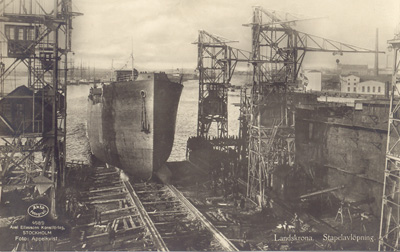
In 1940, Götaverken took over the shipyard and in 1965 it was turned into a production unit only for götaverken. In 1977 Öresundsvarvet became a part of Svenska Varv. In 1982 the last newbuilt ship left the shipyard. The shipyard operations did not die out completely when the production ceased. The operations continued as a shipyard for repairs and rebuildings, first under the name Cityvarvet Öresund but in 1992 the shipyard retook the old name Öresundsvarvet. The construction of huslls has continued on the shipyard's grounds, nowadays under the management of Bruce's Shipyard. The hulls are then towed to shipyards in Norway for completion. This production of hulls is the last remains of the once so extensive swedish production of larger ships.

BERGSUNDS -FINNBODA- EKENSBERG, STOCKHOLM
Bergsunda was established as early as 1769. They didn't produce any ships until the second half of the 19th century, however. At an early stage the location of the shipyard near lake Mälaren proved problematic. The ships could only be so large that they could pass through the lock to get out from Mälaren!
In order to solve this problem the shipyard bought the Finnboda Bruk and changed that plants production into ships. In 1915 Stockholms Rederi AB Svea took over the ownership. At the end of the 1920s Bergsunds was liquidated and the operations were concentrated to Finnboda. In 1970 the shipyard was bought by Saléns which already owned Ekensbergs Varv. Ekensbergs Varv was located in Mälaren and faced the same problems as Bergsunds, the operations were limited by the channel of Södertälje. With the takeover of Finnboda, Saléns liquidated Ekensbergs and moved the equipment and staff to Finnboda. In 1974 Finnboda turned into a part of Götaverken, which was owned by Salén as well. In 1977 Götaverken was incorporated in Svenska Varv and this in turn meant that the shipyard operations in Finnboda were wound up.
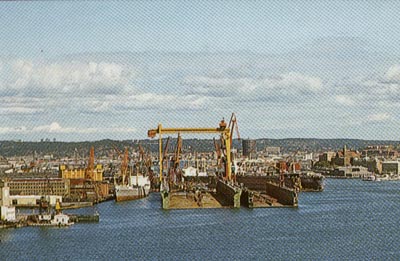
Götaverken Cityvarvet
GÖTAVERKEN- GÖTEBORG
In 1906, Hugo hammar and Sven Almqvist took over the ownership. At this time a considerable build up of the shipyards capacity started. In 1916 the shipyard's name changed to Götaverken. In 1917 it was time for a new owner to take over, now it was time for the Broström's. hugo Hammar remained as manager of the shipyard. In 1933 the business had grown so much that Götaverken was the largest shipyard of the world measured in launched gross tons. Götaverken decided at the end of the 1950-s to build a completely new plant at Arendal, further away on Hising Island. When this plant was ready in 1963 it was unique in the world since most of the constructionwork was performed indoors. At a rate with the completion of the ship it was pushed further out on the bed. As the Arendalplant was put in operation the constructionwork at the old city shipyard was liquidated. The last launching from this shipyard was in 1968. In 1971 the Salén group took over the ownership which in turn left the ownership to Svenska Varv in 1977. During this last period the shipyard struggled to survive and looked for alternatives to the traditional production of tankers and oreships. They tried to aim at producing specialized ships; ice-breakers, ferries and rfrigerating ships. The largest expectations were in the direction of building equipment for the offshore industry, however, and especially of buildning residential platforms for the Göteborg-based company Consafe. When Consafe went bankrupt in 1985 this was all but the very last chance for the shipyard epoch in Göteborg. In 1989 the national ice-breaker Oden was delivered as götaverkens last ship. Götaverken Cityvarvet survived the slaughter on shipyards. Here they continued, although in a slimmer version, with repairs and rebuildings of ships.
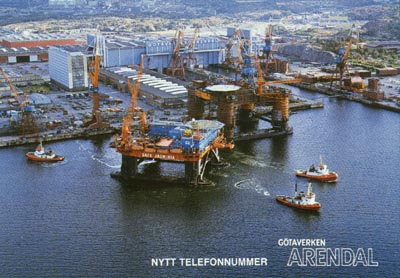
Götaverken Arendal
ERIKSBERG
The shipyard was founded in 1850 by Christian Barchman. The name was then "Ericsbergs metall och tackjerns-gjuteri". From the beginning it was an ordinary mechanical workshop specialised in galvanization. The first ship was not delivered until 1873, a steam tugpinnace. After this the ship production made headway and in 1876 Eriksbergs Mekaniska Verkstad AB was established. In 1915 Broströms took over the stock majority and they remained the shipyards owner until the shipyard crisis six decades later. in 1970 EMV took over the competitor Lindholmens. In 1973 EMV sold their repair business to Götaverken and became a shipyard concentrated on new production only. The shipyard crisis in the 1970-s led the state to take over Götaverken in 1976. At the same time EMV becme an affiliated company to Götaverken.
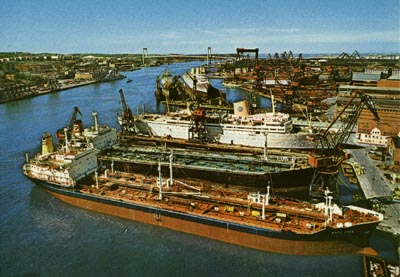
WÄRTSILÄ, Finland
Wärtsilä had two shipyards in Finland. The shipyard in Åbo with a lineage of shipbuilding dating to the middle of the 18th century and Helsingsforsvarvet which was founded in the middle of the 19th century. From 1991 and on these two shipyards are parts of the Norwegian Kvaernaer-group under the name Kvaernaer Masa-yards.
BURMEISTER & WAIN, Danmark.
The shipyard was founded in 1850 in Copenhagen. The shipyard delivered the world’s first ocean-going motor-ship in 1912, M/S Selandia. This delivery gave rise to a long number of orders on similar ships. One example is a series of ships to the Swedish Nordstiernan (Johnson). From now on, apart from shipbuilding, B & W also became an important producer of ship-engines that were delivered to the constructions of other shipyards. B & W managed, in spite of a bankruptcy in 1980, to survive the crisis in the shipping industry but in 1995 the shipyards suffered new economical problems. The business continues after a reconstruction.